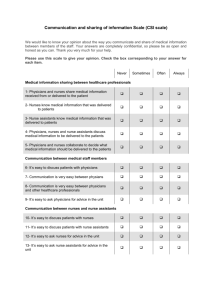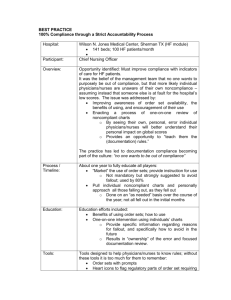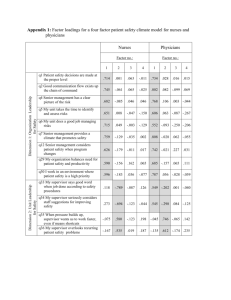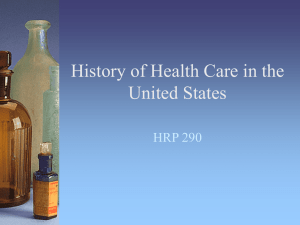Journal of Applied Medical Sciences, vol. 1, no. 2, 2012,... ISSN: 2241-2328 (print version), 2241-2336 (online)
advertisement
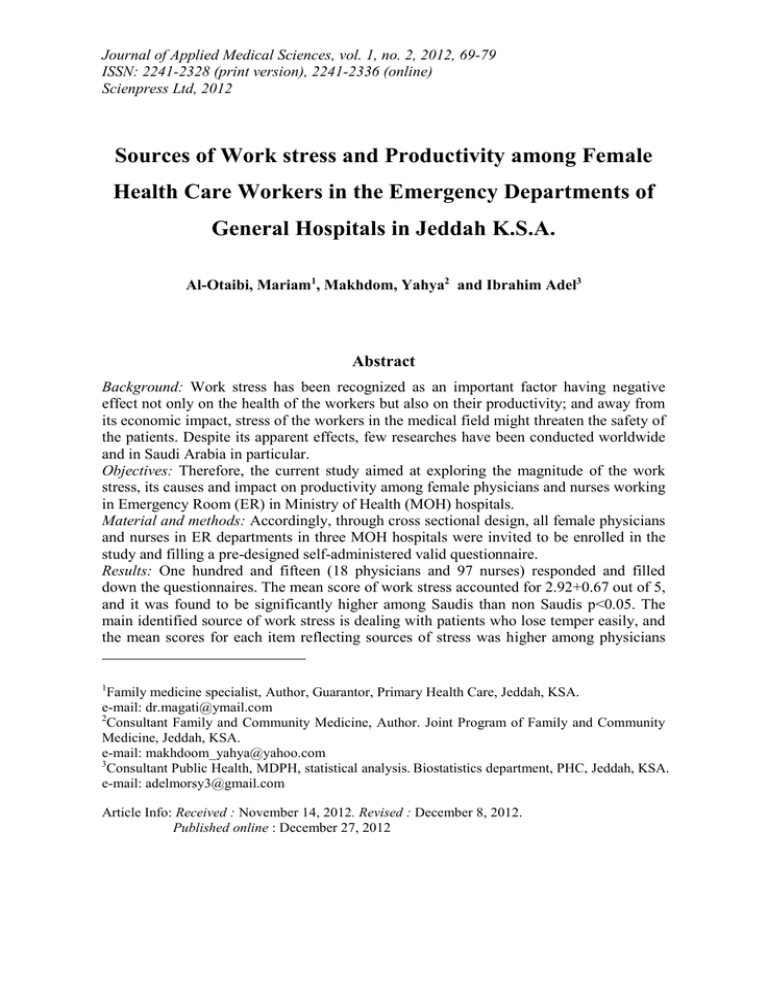
Journal of Applied Medical Sciences, vol. 1, no. 2, 2012, 69-79 ISSN: 2241-2328 (print version), 2241-2336 (online) Scienpress Ltd, 2012 Sources of Work stress and Productivity among Female Health Care Workers in the Emergency Departments of General Hospitals in Jeddah K.S.A. Al-Otaibi, Mariam1, Makhdom, Yahya2 and Ibrahim Adel3 Abstract Background: Work stress has been recognized as an important factor having negative effect not only on the health of the workers but also on their productivity; and away from its economic impact, stress of the workers in the medical field might threaten the safety of the patients. Despite its apparent effects, few researches have been conducted worldwide and in Saudi Arabia in particular. Objectives: Therefore, the current study aimed at exploring the magnitude of the work stress, its causes and impact on productivity among female physicians and nurses working in Emergency Room (ER) in Ministry of Health (MOH) hospitals. Material and methods: Accordingly, through cross sectional design, all female physicians and nurses in ER departments in three MOH hospitals were invited to be enrolled in the study and filling a pre-designed self-administered valid questionnaire. Results: One hundred and fifteen (18 physicians and 97 nurses) responded and filled down the questionnaires. The mean score of work stress accounted for 2.92+0.67 out of 5, and it was found to be significantly higher among Saudis than non Saudis p<0.05. The main identified source of work stress is dealing with patients who lose temper easily, and the mean scores for each item reflecting sources of stress was higher among physicians 1 Family medicine specialist, Author, Guarantor, Primary Health Care, Jeddah, KSA. e-mail: dr.magati@ymail.com 2 Consultant Family and Community Medicine, Author. Joint Program of Family and Community Medicine, Jeddah, KSA. e-mail: makhdoom_yahya@yahoo.com 3 Consultant Public Health, MDPH, statistical analysis. Biostatistics department, PHC, Jeddah, KSA. e-mail: adelmorsy3@gmail.com Article Info: Received : November 14, 2012. Revised : December 8, 2012. Published online : December 27, 2012 70 Al-Otaibi, Mariam, Makhdom, Yahya and Ibrahim Adel than nurses especially those related to dealing with tempered patients, lack of appropriate appreciations, short breaks and having to adapt with negative decisions which showed statistically significant differences between the two groups. Conclusion and recommendations: Working in ER is stressful for female physicians and nurses for many reasons which are mostly modifiable. It was recommended that deliberate efforts should be made to increase the number of working physicians in ER departments and to settle appropriate system for providing them with incentives in the form of training and financial increments. Keywords: Work stress, productivity, physicians, nurses, females, general hospitals, ER, Saudi Arabia. 1 Introduction Stress has been defined as "a negative emotional experience accompanied by a predictable biochemical, physiological, cognitive and behavioral changes that are directed either toward altering the stressful event or accommodating to its effects".(1) Stress in the workplace is costly, expenses came from absenteeism, diminished productivity, increased health insurance charges and direct health-related expenses.(2) Work stress is applicable in most work fields, however, the medical field, in particular is an inherently stressful profession. Health workers are potentially on 24-hours duty with physical and psychological demands which often make physicians more vulnerable to high levels of stress.(3) This stress can impact participation and performance at work through decreased energy for work role, burnout and job dissatisfaction, and even destructive social behaviors and lost productivity.(4) Although many reports suggested that stress among physicians, nurses and other health professionals is high,(5) few researches were conducted to reveal the extent and sources of work stress among professional in the medical field. Therefore, the current study aims at determining the sources and the level of work stress among female medical workers (doctors and nurses) in the emergency departments of public hospitals. Subjects and Methods: This cross sectional descriptive study was conducted in Jeddah Governorate which is the second largest city after Riyadh, capital of Saudi Arabia. There are three general hospitals under direct control of MOH: King Fahad hospital (KFH), King Abdul-Aziz hospital (KAH) and Al-Thager hospital (TH). This study included the emergency departments in these hospitals. All female physicians and nurses (n=177) working in ER department were considered eligible to be enrolled in the study. Those who were available at the time of the study were invited to fill the questionnaire prepared to achieve the study objectives. The number of respondents who were willing to participate and fill the questionnaire accounted for 115 females (18 physicians and 97 nurses) making a response rate of 65%. The non Sources of Work Stress in Emergency Departments 71 respondents were represented by either those who refused to participate even after consistent repeated requests or those who were in vacation. The main tool in this study is a self-administered questionnaire designed by Al Omar BA, 2003, in English language. Reliability Alpha coefficient accounted for 0.93.(6) Provided that the dependent outcomes represented by sources of stress and productivity were displayed in liekert scale, therefore, the first step was to convert the response to each item to a numeric scale using a scoring system ranging between 1 for strongly disagree and 5 for strongly agree for the items of the sources of work stress, and from “1” for rarely or none to “5” for always for the items evaluating productivity after reverting items of penalization at work and leaves for absence. The responses on the two modules were summed up to get an overall score for each module per each participant. These scores were dealt with as a quantitative variables, and test for normality was conducted which revealed its normal distribution, therefore, independent sample t test was used for comparing two subcategories and ANOVA test for more than two subcategories. Pearson Correlation was used to test the relationship between two quantitative variables e.g. scored sources of stress and scored productivity. P value <0.05 was considered significant throughout the study. The researcher complied with the ethical considerations of the scientific research concerning permissions from relevant authorities; verbal consent from each participant was considered a prerequisite for inclusion in the study. All data were kept confidentially and would not be disclosed except for the study purposes. 2 Main Results The mean age of the respondents accounted for 30.6+6.5 years and almost half of them (47.8%) aged less than 30 years; most are non Saudis (73.9%) and singles (47%). The physicians constituted 15.7%; and 45.2% of the participants have university and postgraduate qualifications. The majority of the participants (70.4%) agree that working with opposite sex is one of the main sources of work stress and almost two thirds (60.8%) agree that patients who lose their temper very quickly comprise a main source of work stress, and slightly lower percentage (59.2%) perceive that the work stress in being dealing with risky job or tasks. On the same line, it was observed that almost half of the participants (54.8%) indicated that they perceive work stress from the frequent changes in the work shift [Table 1]. The mean stress scores were higher among younger respondents (3.00) if compared to their older mates. Meanwhile, it was noticed that the mean stress scores was significantly higher among Saudi respondents (3.47) than that among the non Saudis (2.82). On the other hand, it was realized that although the stress scores were higher among singles (3.04), physicians (3.09) and postgraduates if compared to their counterparts, however, these differences are not statistically significant p>0.05 [Table 2]. The most frequently reported work related activities are “fulfilling the full work hours”, followed by fulfilling the work shifts, arriving to work on time and obeying the rules and regulations at work. However the least work related activity indicated by the participants is working overtime hours. On the other side, it was realized that only 8.7% of the respondents expressed that they are always rewarded for their work, and 5.2% who 72 Al-Otaibi, Mariam, Makhdom, Yahya and Ibrahim Adel addressed that they are always penalized at work [Table 3]. The mean stress scores were higher among physicians in almost all items, however, these differences were statistically significant for only four items; namely: dealing with patients who lose temper very quickly, absence of appreciation of good work, short breaks and having to adapt with negative decisions where the differences showed statistical significance p<0.05 [Table 4]. It was found that there is slight inverse correlation between scores reflecting stress at work as expressed by the participants and the scores reflecting their work activity (r=-0.023; p=0.807) [Figure 1]. Table 1a: Agreement of the participants on the probable items for work stress. Probable sources of work stress SD DA NS A Patients lose temper very quickly 0.9 23.5 14.8 33.0 Working with opposite sex 4.3 14.8 10.4 57.4 Dealing with risky job or tasks 8.7 20.0 12.2 40.9 Work shifts are changing frequently 1.7 30.4 13.0 41.8 Limited opportunities for enhancement and development 3.5 33.0 18.3 32.2 Supervising the work of others 7.0 25.1 22.6 35.7 Absence of appreciation of good work 4.3 35.7 15.7 28.7 Insufficient technical facilities 4.3 38.3 12.2 30.4 Other sources of job stress 0.9 25.2 45.2 20.0 Difficulties in having vacations or leaves 3.5 40.0 14.8 27.0 Conflicting requests 5.2 30.4 26.1 29.6 Absence of financial incentives 2.6 40.0 22.6 23.5 Short breaks 3.5 44.3 15.7 23.5 Having to adapt negative decision 4.3 37.4 21.7 28.7 Limited opportunities for training and education 5.2 42.6 14.8 24.3 Ineffective communication system 8.7 33.9 20.9 26.1 Salary doesn't match with the required tasks 5.2 42.6 17.4 20.9 Attending lots of committees 4.3 41.7 17.4 29.6 Unhealthy work environment 7.8 43.5 11.3 23.5 No participation in department's decision making 6.1 43.5 14.8 23.5 Ambiguity in the job role 4.3 35.7 33.0 20.0 SD “Strongly disagree” DA “Disagree” NS “Not satisfied” A “Agree” SA “Strongly agree SA 27.8 13.0 18.3 13.0 13.0 9.6 15.7 14.8 8.7 14.8 8.7 11.3 13.0 7.8 13.0 10.4 13.9 7.0 13.9 12.2 7.0 73 Sources of Work Stress in Emergency Departments Table 1b: Agreement of the participants on the probable items for work stress (Continued). Probable sources of work stress Absence of cooperation between colleagues Unfair performance evaluation Job requirement is more than ability Lacking ability to catch up the rapid technology changes Unclear hospital policies Promotion depends only on personal relationship Lack of stability at home Lack of spouse satisfaction of my job Working hours don't fit with personal life Unclear promotion requirements Having to work long hours Lack of power and influence Ability and talent are not used properly Improper relationship with colleagues Being not respected Hospital objectives don't match mine Disagreement with subordinate or head of department Feeling isolated Threat of not re-contracted SD 9.6 8.7 5.2 DA 33.9 37.4 42.6 NS 25.2 18.3 20.1 A 22.6 29.6 27.8 SA 8.7 6.1 4.3 7.8 9.6 10.4 8.7 7.0 3.5 7.0 4.3 7.0 11.3 6.1 13.9 7.8 13.0 20.9 8.7 47.0 37.4 38.3 44.3 41.7 48.7 40.0 55.7 48.7 42.6 52.2 47.0 47.8 51.3 45.2 53.0 9.6 21.7 19.1 14.8 27.8 25.2 27.0 15.7 19.1 20.9 20.0 8.7 23.5 13.0 10.4 28.7 26.1 26.1 25.2 23.5 13.0 12.2 20.9 13.9 18.3 20.9 14.8 21.7 15.7 16.5 18.3 7.8 9.6 5.2 7.0 8.7 10.4 10.4 5.2 10.4 7.0 4.3 7.0 8.7 5.2 6.1 5.2 1.7 SD “Strongly disagree” DA “Disagree” NS “Not satisfied” A “Agree” SA “Strongly agree” Table 2: Average stress scores for the participants according to their demographic characteristics. Characteristics Mean score. P value Age group <30 years 3.00 30-<40 years 2.83 0.448 40+ years 2.89 Nationality Saudi 3.47 <0.001 Non Saudi 2.73 Marital status Single 3.04 0.085 Married 2.82 Job Physician 3.09 0.257 Nurse 2.89 Working status Diploma 2.92 University 2.87 0.067 Postgraduate 3.80 74 Al-Otaibi, Mariam, Makhdom, Yahya and Ibrahim Adel Table 3: Response of the participants to the items reflecting work activity and achievements. Rarely Sometimes Frequently Often Always 3.5 -- 5.2 8.7 82.6 Arrive to work on time 4.3 5.3 -9.0 4.3 5.3 8.7 49.1 82.6 74.8 Obey the rules and regulations at work 4.3 -- 7.8 7.8 80.0 Perform assigned tasks 5.2 -- 7.0 15.7 72.2 Achieve high level of performance 11.3 13.9 12.2 20.9 41.7 Attend conferences and meetings 14.8 26.1 13.9 13.0 32.2 Do overtime hours 23.5 40.0 13.0 3.5 20.0 Achievements Was rewarded for work 49.6 28.7 9.6 3.5 8.7 Was penalized at work 56.5 30.4 5.2 2.6 5.2 Annual performance reports are excellent 28.7 13.0 15.7 17.4 25.2 Take leaves of absence 84.3 7.8 2.6 2.6 2.6 Performance and achievement Performance Fulfil work hours Fulfil shifts Table 4a: Comparing the responses to the items reflecting probable sources of stress between physicians and nurses. Items reflecting sources of stress Physicians Mean score Patients lose temper very quickly Working with opposite sex Dealing with risky job or tasks Work shifts are changing frequently Limited opportunities for enhancement and development Supervising the work of others Absence of appreciation of good work Insufficient technical facilities Other sources of job stress Difficulties in having vacations or leaves Conflicting requests Absence of financial incentives Short breaks Having to adapt negative decision Limited opportunities for training and education Ineffective communication system Salary doesn't match with the required tasks Attending lots of committees Unhealthy work environment 4.17 3.50 3.56 3.11 3.56 2.78 3.67 3.17 3.44 3.56 3.22 3.39 3.78 3.50 3.39 3.22 3.28 3.00 3.01 * Statistically significant Nurses Mean score 3.54 3.62 3.37 3.38 3.12 3.23 3.07 3.12 3.04 3.01 3.03 2.94 2.84 2.89 2.90 2.91 2.89 2.92 2.90 P 0.017* 0.657 0.565 0.340 0.146 0.119 0.048* 0.890 0.85 0.073 0.492 0.109 0.001* 0.026* 0.107 0.297 0.213 0.768 0.786 75 Sources of Work Stress in Emergency Departments Table 4b: Comparing the responses to the items reflecting probable sources of stress between physicians and nurses. Items reflecting sources of stress Physicians Mean score No participation in department's decision making Ambiguity in the job role Absence of cooperation between colleagues Unfair performance evaluation Job requirement is more than ability Lacking ability to catch up the rapid technology changes Unclear hospital policies Promotion depends only on personal relationship Lack of stability at home Lack of spouse satisfaction of my job Working hours don't fit with personal life Unclear promotion requirements Having to work long hours Lack of power and influence Ability and talent are not used properly Improper relationship with colleagues Being not respected Hospital objectives don't match mine Disagreement with subordinate or head of department Feeling isolated Threat of not re-contracted 3.33 3.00 2.89 3.06 2.67 2.72 5.99 6.01 6.70 5.99 5.44 6.87 6.87 6.24 6.75 5.44 6.28 6.50 6.39 6.50 6.39 Nurses Mean score 2.85 2.88 2.87 2.84 2.87 2.85 6.82 6.88 6.87 6.81 6.84 6.88 6.20 6.84 6.24 6.32 6.21 6.28 6.36 6.16 6.50 * Statistically significant Figure 1: Correlation between work stress and work activity P 0.109 0.633 0.938 0.445 0.478 0.699 9.194 9.187 9.577 9.525 9.416 9.072 9.830 9.848 9.143 9.923 9.056 9.674 9.038 9.049 9.246 76 Al-Otaibi, Mariam, Makhdom, Yahya and Ibrahim Adel 3 Discussion The overall mean stress score for the respondents (2.92+0.67) indicates work stress among the participants. This tendency could be attributed to the nature of work in ER which is characterized mainly by night shifts and dealing with critical cases. Night work is associated with a significant increase in average cortisol secretion regardless of job strain or work hours.(7) Therefore, it is expected that the additive effect of the other sources of stress represented by the clinical conditions of most of the patients and long working hours could act synergistically in increasing the possibilities for occurrence of work stress among physicians and nurses in ER. Another possible additive factor which is related to the gender of the group in our sample is being a female to a greater extent tend to express lack of autonomy at their working situation as it was shown in a study conducted recently in USA.(8) Similar to our findings, Al-Omar through his study to find out the demographic factors associated with work stress among MOH hospital staff revealed that Saudis were higher in the level of work stress than non-Saudis.(6) This notion could be attributed partially to the differences in the levels of the daily social commitments and responsibilities shouldered by the two groups i.e. while a considerable proportion of the non Saudi females are living away from their families within local dormitories and they have no daily familial or social responsibilities, on the contrast, the Saudis are living within their close and large families. This social situation of the Saudi females necessitate care of their husbands, their children, and to provide attention to their parents and other family members. To meet these responsibilities, they have to have adequate time and activity, which are usually consumed at work, therefore, conflicts between work and social responsibilities usually create feeling of work stress. In accordance with the findings reported among health workers in Riyadh,(6) work stress was found to be inversely correlated with age. This pattern of correlation can be attributed to many factors, firstly, as it is well known that with aging there is cumulative experience both in the job skills and work environment in general which enable the worker to adapt efficiently with the work disciplines, colleagues and the patients. This explanation is supported by the findings of a study conducted on Japanese nurses which pointed out to the increased emotional exhaustion and work stress among newly graduated nurses because they are facing professional challenges as they are deemed to cope with the work values and to act hard for career development.(9) Also, similar findings were reported in UK among junior health care workers and it was explained by the fact that although perceptions and practices of junior healthcare managers suggest that there is a culture of acceptance and expectation of work stress, however, there is a lack of awareness to effectively and proactively manage it.(10) Another factor which is usually realized in clinical work especially in ER is the relatively increased frequency of shifts among juniors than that for older senior mates. Moreover, it is assumed that the older personnel are more socially stable than the young ones. Despite the relatively higher work stress levels among physicians than nurses showed no statistically significant differences, nevertheless, this difference had been asserted in a study conducted in USA which showed that emotional stress scores among physicians were nearly 50% higher than those of nurses.(11) This difference could be attributed to the relatively higher responsibilities and critical decision making laid on physicians rather than nurses. In most instances, the patients who are attending ER are perceiving that their medical Sources of Work Stress in Emergency Departments 77 conditions are critical and they deserve emergency care, however, and as it was shown in many studies,(12) a considerable proportion of them are not actually emergency cases, therefore, the health care workers in the ER are delaying them till they provide necessary care for those who are clinically in more need for it. This situation usually creates a congested perception of the patients which is translated into aggressive reactions towards the health workers in the ER. Accordingly, it was realized in our study that the first source of work stress as expressed by our respondents is the patients who lose their temper very quickly. On the same line, and provided that the physicians who are taking the responsibility of prioritizing the patients according to their clinical condition, therefore, they are significantly more likely to face patients who lose temper than that among the nurse p<0.05. Moreover, and regarding the same explanation, it was found that the physicians are significantly more prone to suffer from the stress resulting from negative decisions than that among nurses p<0.05. At the individual level, with respect to the work disciplines and employees’ management, it was found that physicians are significantly more likely to feel stress initiated from lack of appropriate appreciation than nurse p<0.05. This difference could be attributed to the usual insight perception of the physicians that they are shouldering the main and critical compartment of clinical care provided to the patients, nevertheless, they feel that they are not taking equal value of appreciation. Moreover, it was recognized that among the sources of stress which showed significant differences between physicians and nurses is the short breaks, where physicians showed higher stress scores than nurses p<0.05. This difference could be attributed to the relative abundance of both groups. The relatively more number of nurses permit relatively longer short breaks than that for physicians. There is a negative correlation between job stress and job performance, and in the field of medicine, health workers have to usually face a lot of challenges and one of the most evident factor which originates and impacts directly their personal and professional lives is stress. On the other hand, low job satisfaction correlated with contemplation of giving up work due to stress and those subjects who have high level of job stress have usually low job performance.(13) Such negative outcome places at the life of the innocents who attend the ER at critical situations and such stresses increases the chances of fatal errors that in turn lowers job performance.(14) These assumptions and findings had been shown among our participants where it was demonstrated that there is an inverse correlation between the level of work stress and their performance. 4 Conclusion and Recommendations Working in ER is a stressful job, and the main cause of stress is the type of patients whether being critical or losing temper easily; physicians are more prone to suffer from stress, and the main sources of stress are dealing with bad tempered patients, absence of appreciation of good work, short breaks and having to adapt negative decision. Being Saudi was the only demographic factor that was found to increase significantly the likelihood of having work stress. Deliberate efforts should be made to increase the number of physicians working in ER to ensure adequate time assigned for each patient and to increase possibilities to have enough break times, and to decrease the frequency of night shifts designated for each physician especially for Saudi physicians. Selective training courses focusing on 78 Al-Otaibi, Mariam, Makhdom, Yahya and Ibrahim Adel communication skills especially with tempered patients should be delivered for physicians and nurses working in ER. ACKNOWLEDGEMENTS: The authors would like to thank all physicians and nurses working in the ER departments in King Fahad hospital, King Abdul-Aziz hospital and Al-Thager hospital for providing their valuable time in the interview and filling up the questionnaires. References [1] A. Baum, Stress, intrusive imagery and chronic distress, Health Psychol, 9(6), (1990), 653 - 75. [2] PJ. Rosch, The Health Effects of Job Stress, Business and Health, (1984), 4-8. [3] U. Niaz, S. Hassan and S. Ali, Stress in Women Physicians in Pakistan, Pak J Med Sci, 19(2), (2003), 89 - 94. [4] R. Kazmi, S. Amjed and D. Khan, Occupational Stress and its Effect on Job Performance: A Case study of medical house officers of district Abbottabad, J Ayub Med Coll Abbottabad , 20(3), (2008), 135 - 9. [5] AS. Al-Aameri, Source of job stress for nurses in public hospitals, Saudi Med J, 24(11), (2003), 1183 - 7. [6] BA. Al-Omar, Sources of work-stress among hospital-staff at the Saudi MOH. JKAU, Econo & Adm, 17(1), (2003), 3 - 16. [7] C. Thomas, C. Hertzman and C. Power, Night work, long working hours, psychosocial work stress and cortisol secretion in mid-life: evidence from a British birth cohort, Occup Environ Med, 66(12), (2009), 824 - 31. [8] E. Torkelson, T. Muhonen and JM. Peiro, Constructions of work stress and coping in a female- and a male-dominated department, Scand J Psychol, 48(3), (2007), 261 - 70. [9] E. Rebecchi, M. Benassi, R. Bolzani and A. Santullo, The influence of professional values in the emergence of work stress and burn-out in newly graduated nurses, G Ital Med Lav Ergon, 31(1), (2009), 30 - 35. [10] K. Rodham and J. Bell, Work stress: an exploratory study of the practices and perceptions of female junior healthcare managers, J Nurs Manag, 10(1), (2002), 5 - 11. [11] T. Rutledge, E. Stucky, A. Dollarhide, M. Shively, S. Jain, T. Wolfson, et al, A real-time assessment of work stress in physicians and nurses, Health Psychol, 28(2), (2009), 194 - 200. [12] H. Hansagi, M. Olsson, A. Hussain and G. Ohlen, Is information sharing between the emergency department and primary care useful to the care of frequent emergency department users?, Eur J Emerg Med, 15(1), (2008), 34 9. Sources of Work Stress in Emergency Departments 79 [13] D. Anthony, A Survey of Job Satisfaction, Sources of Stress and Psychological Symptoms Among New Zealand Health Professionals, New Zealand Medical Journal, 114, (2001), 540 - 44. [14] K. Rubina, Occupational Stress and its Effects on Job Performance; A Case Study of Medical House Officers of District Abottabad, First Proceedings of International Conference on Business and Technology. Iqra University Islamabad, (2007), 182 - 6.
